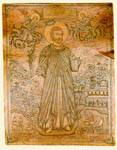|
|
| Athonite Paper Icons |
27 July 1829 Collection of Simonopetra Monastery Engraved copperplate 48.8 x 36.7 cm Engraved in Hydra Engraver: Agathangelos Triantaphyllou of Serres, hierodeacon |
|

|
Inscription: Aύτη η εικών εχαλκοχαράχθη δι' εξόδων τε του οσιωτάτου κυρίου Γερασίμου Yδραίου: 1829 Iουλίου: 27 εν 3/4δρα διά χειρός αγαθαγγέλου ιεροδιακόνου του εκ Σερρών εχάραξε (This icon was commissioned by the most pious Gerasimos of Hydra: 1829 July: 27 in Hydra, engraved by the hand of Agathangelos of Serres, hierodeacon). The neomartyr, dressed in ecclesiastical vestments, stands full-length in the centre of the icon, holding a palm branch in his left hand and the martyr's cross in his right. Behind him the densely populated town of Hydra climbs up two hills. The large church at lower left with the tall bell tower is the Monastery of the Virgin, the present cathedral, and the monastery of Prophet Elijah can be seen high up on the mountain. On the sea are rowing boats and ships under full sail. In the heavens, on the left among clouds, Christ, with a closed book in his hand, blesses the saint, while on the right an angel places the martyr's crown on Constantine's head. Between the two iconographic figures is the inscription: [Icon] of the holy and glorious new martyr Constantine of the famous island of Hydra, who suffered death for Christ's sake on the island of Rhodes. printed for the benefit of Orthodox Christians. The neomartyr Constantine was born on Hydra in the eighteenth century and at the age of eight went to Rhodes, where he became a Muslim. He later reverted to the Orthodox faith and became a monk in the Monastery of Iviron on Mount Athos. He returned to Rhodes to preach the Word of God, and the Turkish authorities imprisoned him for apostasy. He was hanged on 14 November 1800. This is a fine engraving in a folk style by the hierodeacon Agathangelos Triantaphyllou from Nigrita near the town of Serres, who later taught engraving at the School of Art (Polytechnic) at Athens (1843-56). Although his five known works include none specifically mentioned as being done on Mount Athos, the time he spent there, before 1826, as a monk and engraver is clearly responsible for the purely Athonite style of the icon. The much simpler work engraved in a folk style in 1877 on Hydra by the hieromonk Gabriel of Skopelos is based on the same iconography.
| |
|
Bibliography: Papastratou 1986, no. 277.
| ||
| H.I.S. | ||
| Index of exhibits of Monastery of Simonopetra 19th century |
||
Reference address : https://www.elpenor.org/athos/en/e218ad14.asp